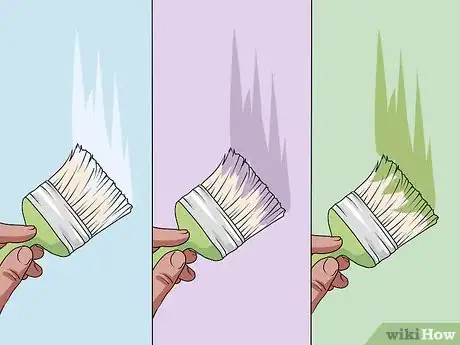This article was co-authored by Juli Roland and by wikiHow staff writer, Amy Bobinger. Juli Roland is a Color Specialist and the Founder of PaintColorHelp.com, one of the first companies in Dallas, Texas metro area that provides in-home color consultations and helps clients create paint color schemes. Juli has over 15 years of commercial and residential color consulting experience, including seven years as a custom-matcher in the paint industry. She earned her certification in color strategy from Camp Chroma and is a member of the Inter-Society Color Council. She has a BA in Advertising from Texas Tech University.
This article has been viewed 256,656 times.
Choosing the perfect paint color for your bedroom may seem a little tricky. Luckily, you can make the decision easier by thinking about the environment you want to create in your room, then picking a color that creates that feeling. For instance, you might choose a blue shade if you want a cozy, calming room, or you might go with yellow for a more cheerful atmosphere. Start by looking for style inspiration, then choose a color family and hue. You can also try out different painting techniques to make your room pop!
Steps
Finding a Starting Point
-
1Look online or in magazines for pictures to help you define your style. If an endless array of color choices is starting to overwhelm you, create an inspiration board. Either collect pictures from design magazines and attach them all to a whiteboard or corkboard or use an online site like Pinterest to save pictures you find while you’re browsing.
Once you collect about 10-15 pictures you love, pick out the colors you see most often to help make your decision easier.[1]
Often, you’ll find that you’re drawn to similar images again and again. If your inspiration board is really eclectic, you might opt for a neutral paint color, then scour flea markets, thrift stores, and home decor shops for unique, funky art and decor you can hang on the walls. -
2Base your color scheme on your furniture for a cohesive look. Unless you’re furnishing your bedroom from scratch, it’s a good idea to consider the furniture, bedding, and decor you already have when you’re choosing a paint color. For instance, if you have a painting in your bedroom that you absolutely love, you might pick out a subtle tone from the picture as the inspiration for your walls.
You can also use colors from other dominant pieces like your floor rug, a chair, or your bedspread, and choose paint colors that match these hues.[2]- You’ll often find that it’s easier to match your paint color to the items you already have, rather than trying to buy new items that will complement your paint.
- If you introduce an entirely new color that doesn’t match your furniture, you may make your bedroom look too busy or chaotic. Your wall color doesn't need to match your furniture perfectly, but it should all flow together.
- For instance, if you have white furniture, you might pick serene tones like light blue or lavender to complete the calm feel. For brown furniture, you might consider a beige wall color.
Did You Know? If you have a small bedroom, picking lighter shades can open up the space to make it feel bigger. If your room is larger, dark colors can help create a cozier, more intimate ambiance.
Advertisement -
3Opt for neutrals if you want the focus to be on your furniture and decor. Neutrals are colors like white, grey, and tan, although they can also include very light shades of other colors, including green, yellow, pink, and blue.
Neutrals tend to fade into the background, so they’re great for creating a subtle ambiance. You can then use your furnishings, bedding, and decor to add pops of color to your room.[3]- For instance, if you have furniture made of dark wood, you might paint your walls warm beige and find bedding in a warm floral pattern you really love. Then, you could add a bold rug, curtains, and artwork in colors that reflect the tones in your bedding for a cozy, cheerful feel.
- If you prefer a more modern bedroom, you could paint your room in a sophisticated grey tone, then decorate with industrial-inspired furniture and sparse—but striking—decor. However, you could also use colors like teal, lavender, and yellow to brighten up the room and make it feel cozier.
- You can use soft white bedding and nature-inspired shades to turn white walls into an inviting and romantic atmosphere, or you can use the white backdrop as a stark backdrop for bold art and patterned bedding.
-
4Avoid using colors that are too bold in your bedroom. Primary colors and other over-saturated hues can be overwhelming in a bedroom.
It’s best to use colors that are softened slightly, such as a red tinted with grey or blue that’s been mixed with a little white. Then, you can introduce brighter splashes of that color in your other design details like your bedding or wall hangings.[4] [5]
For instance, instead of using crayon red in your room, you might opt for a slightly darker ruby shade for a more sophisticated feel.
Choosing a Color Family
-
1Paint your room blue to make it feel like a peaceful escape from the world. Blue is a soothing color, so it’s perfect for helping you relax at the end of a long day. Choose light blues and aquas if you want to create a carefree, calming atmosphere, or go with medium to deep blues for a more tranquil feel.[6] [7]
- For instance, you could paint your walls a soft blue-green color, then add warm wood furniture and graphic black-and-white prints for a room that’s timeless and fresh.
- If your style is bold, sophisticated, and modern, paint 3 of your walls a sand color, then add a navy blue accent wall. Contrast that with copper wall hangings and an industrial light fixture.
-
2Choose green paint to create a nurturing atmosphere. Spending time in nature can be very relaxing, which is why painting your bedroom green will make it feel so peaceful.
Light green is perfect for creating an earthy backdrop that will remind you of spring and renewal, medium-toned green can make your room feel like a cozy escape, and deep, saturated green tones will call to mind the moody drama of the forest.[8] [9]- For instance, you might paint your walls dark green, then brighten the room with light wood furniture, white bedding, and decorations made of wood and brass.
- Pale green is a perfect choice for a peaceful nature-themed nursery.
-
3Play with soft shades of yellow for a cozy, happy bedroom. Golden hues create warmth, while pale hues open a space and create the illusion of additional light. However, you may want to avoid bright green-based yellows, which may be too dramatic to use as bedroom wall paint.[10] [11]
- Using yellow on your walls is a great way to put yourself in a good mood at the end of the day, and it will also make you feel energized when you wake up in the morning.
- Paint your walls a sunny shade of pale yellow, then decorate with whites, tans, and even fun pops of nature-inspired colors like teal or lilac.
-
4Add passion with rich shades of red or orange. While painting your walls in such bright colors is certainly a bold choice, hues like burgundy red and burnt orange can inspire warmth and passion in your bedroom. However, choose the shades carefully, as over-saturated red and orange tones might be too energizing, making it hard to sleep at night.[12] [13]
- If you’re worried that using bold shades will be too overwhelming in your room, consider painting a red accent wall behind your bed. Then, you can use a calming grey or tan on the other walls to soften the effect.
- Pair dark furnishings, bedding, and curtains with a rich burnt orange for a moody, sophisticated feel.
- These invigorating colors are a great choice if you have a hard time waking up in the morning, as they’ll give you an instant pick-me-up.
-
5Use violet to create an air of serenity and romance. Painting your walls violet can make your bedroom feel vintage and romantic. Cooler shades of purple, like lilac and periwinkle, are perfect if you want a peaceful, harmonic vibe, and warmer shades of purple, such as magenta, lavender, and eggplant, are more cheerful and bold.[14]
- Deep purples look fantastic paired with other jewel tones, like sapphire blue, emerald green, and ruby red.
- Accent soft lilac walls with natural wood furniture and pops of a cool, bold color like maroon to make your room feel fresh and comforting.
Trying Different Techniques
-
1Paint an accent wall to add depth and variety to your walls. If there’s a color you love but it’s a little too intense to paint throughout your whole bedroom, try painting just one wall that shade instead.
You might paint the wall behind your bed, or you may pick another wall, like the side of your room with a closet or a window. Then, pick a coordinating color for the rest of the walls.[15] [16]- For instance, a magenta accent wall would be perfectly complemented by sand-colored paint.
- If your style is really bold, you might even paint an all-black accent wall! Use metallic accents and bold colors to add contrast and movement.
- You can even paint your accent wall a different value of the color on your other walls. For instance, if your walls are a light grey, you might pick a slate grey accent wall for a monochrome look.
-
2Paint the ceiling to add extra color to the room. Many people only think about the wall color, but you can also paint the ceiling of your bedroom to create an entirely different mood. Choose a color that will pair with your wall colors, and avoid using dark colors on your ceiling, as this could make your bedroom feel claustrophobic.[17]
- If you have a low ceiling, open it up by painting it vibrant white or pale blue.
- If you have a high ceiling, you can create a warmer, more enclosed space by painting it a shade or two darker than the color you have on your walls.
-
3Paint samples before you commit to a color. The lighting in your bedroom can make a color look dramatically different than it does in the store.
Once you’ve come up with 3 or 4 paint colors you’re considering, buy a small sample container of each color, and paint each one in a 1 ft × 1 ft (0.30 m × 0.30 m) square on your wall. Then, spend a few days observing how the colors look at different times of the day as the light changes and choose the color you like the most.[18]- The lamps and light fixtures you use in the room will also affect how the walls look throughout the day.
Expert Q&A
-
QuestionHow do you test paint colors?
 Juli RolandJuli Roland is a Color Specialist and the Founder of PaintColorHelp.com, one of the first companies in Dallas, Texas metro area that provides in-home color consultations and helps clients create paint color schemes. Juli has over 15 years of commercial and residential color consulting experience, including seven years as a custom-matcher in the paint industry. She earned her certification in color strategy from Camp Chroma and is a member of the Inter-Society Color Council. She has a BA in Advertising from Texas Tech University.
Juli RolandJuli Roland is a Color Specialist and the Founder of PaintColorHelp.com, one of the first companies in Dallas, Texas metro area that provides in-home color consultations and helps clients create paint color schemes. Juli has over 15 years of commercial and residential color consulting experience, including seven years as a custom-matcher in the paint industry. She earned her certification in color strategy from Camp Chroma and is a member of the Inter-Society Color Council. She has a BA in Advertising from Texas Tech University.
Certified Color Specialist You want to see large patches of the color. Make sure it’s covering the wall completely; a mini-roller puts on a better coat than a foam brush, which can streak the paint. If you're testing a white, make sure the sample you get is close to the chip. Some whites do not render accurately in the sample size, and the only way to see the true color is by purchasing the real gallon of paint.
You want to see large patches of the color. Make sure it’s covering the wall completely; a mini-roller puts on a better coat than a foam brush, which can streak the paint. If you're testing a white, make sure the sample you get is close to the chip. Some whites do not render accurately in the sample size, and the only way to see the true color is by purchasing the real gallon of paint. -
QuestionWhat colors are best for bedrooms?
 Katherine TlapaKatherine Tlapa is an interior designer, currently working as a Design Specialist for Modsy, a design service based in San Francisco. She also runs her own DIY Home Design blog, My Eclectic Grace. She received her BFA in Interior Architecture from Ohio University in 2016.
Katherine TlapaKatherine Tlapa is an interior designer, currently working as a Design Specialist for Modsy, a design service based in San Francisco. She also runs her own DIY Home Design blog, My Eclectic Grace. She received her BFA in Interior Architecture from Ohio University in 2016.
Interior Designer This depends on your style. A lot of paint colors look nice in a bedroom, but you want to steer clear of bright and vibrant colors that make the room too energizing like bright yellow, orange, red, and blue.
This depends on your style. A lot of paint colors look nice in a bedroom, but you want to steer clear of bright and vibrant colors that make the room too energizing like bright yellow, orange, red, and blue. -
QuestionWhat is the most relaxing color to paint a bedroom?
 Katherine TlapaKatherine Tlapa is an interior designer, currently working as a Design Specialist for Modsy, a design service based in San Francisco. She also runs her own DIY Home Design blog, My Eclectic Grace. She received her BFA in Interior Architecture from Ohio University in 2016.
Katherine TlapaKatherine Tlapa is an interior designer, currently working as a Design Specialist for Modsy, a design service based in San Francisco. She also runs her own DIY Home Design blog, My Eclectic Grace. She received her BFA in Interior Architecture from Ohio University in 2016.
Interior Designer Colors that are not very saturated, like a pale blue, warm grey, or light brown are very soothing. Having light and airy colors will make the space more relaxing and make it easier to sleep and feel at peace.
Colors that are not very saturated, like a pale blue, warm grey, or light brown are very soothing. Having light and airy colors will make the space more relaxing and make it easier to sleep and feel at peace.
References
- ↑ https://www.heytherehome.com/8-tips-choosing-right-paint-color/
- ↑ https://www.heytherehome.com/8-tips-choosing-right-paint-color/
- ↑ https://www.heytherehome.com/8-tips-choosing-right-paint-color/
- ↑ Juli Roland. Certified Color Specialist. Expert Interview. 27 March 2020.
- ↑ https://food52.com/blog/23443-best-colors-to-paint-bedroom-according-to-interior-designer
- ↑ Juli Roland. Certified Color Specialist. Expert Interview. 27 March 2020.
- ↑ https://www.architecturaldigest.com/story/bedroom-color-ideas
- ↑ Juli Roland. Certified Color Specialist. Expert Interview. 27 March 2020.
- ↑ https://www.architecturaldigest.com/story/bedroom-color-ideas
- ↑ Juli Roland. Certified Color Specialist. Expert Interview. 27 March 2020.
- ↑ https://www.architecturaldigest.com/story/bedroom-color-ideas
- ↑ Juli Roland. Certified Color Specialist. Expert Interview. 27 March 2020.
- ↑ https://www.architecturaldigest.com/story/bedroom-color-ideas
- ↑ https://www.architecturaldigest.com/story/bedroom-color-ideas
- ↑ Juli Roland. Certified Color Specialist. Expert Interview. 27 March 2020.
- ↑ https://www.heytherehome.com/8-tips-choosing-right-paint-color/
- ↑ https://www.apartmenttherapy.com/tackling-the-fifth-wall-how-to-choose-ceiling-paint-color-207796
- ↑ https://www.apartmenttherapy.com/10-common-color-mistakes-you-should-stop-making-210655
About This Article
To choose paint color for a bedroom, consider the color of your current furniture as a starting point. Creating a cohesive look is usually much easier if you match paint colors to items you already have in the room rather than buying new items to match the paint color you choose. If you aren't sure or think you might buy new furniture and decor in the future, you can always opt for a neutral paint color like beige, white, or gray. For example, light gray paint will probably go well with your current furnishings and anything new that you buy. You can always incorporate pops of color by adding or changing furnishings, bedding, and other decor. For tips from our Interior Designer co-author on choosing colors to create a particular mood, keep reading!

































































